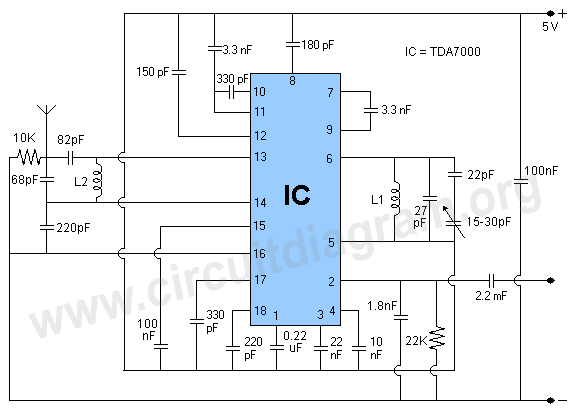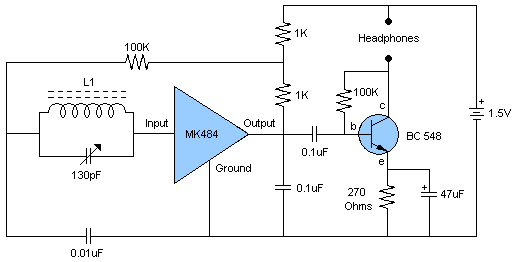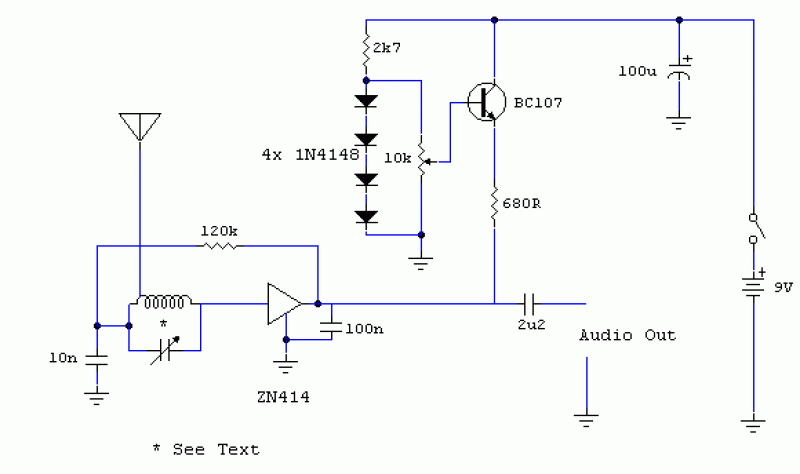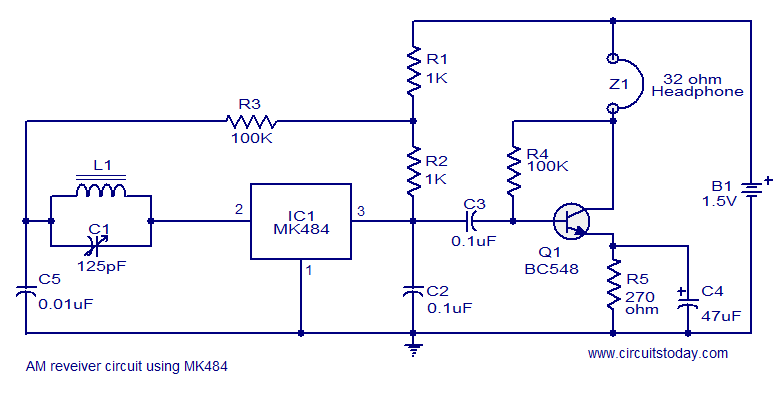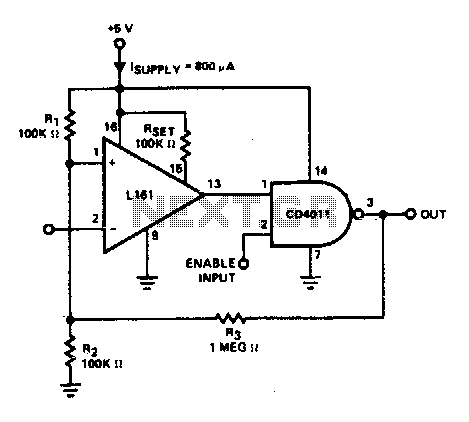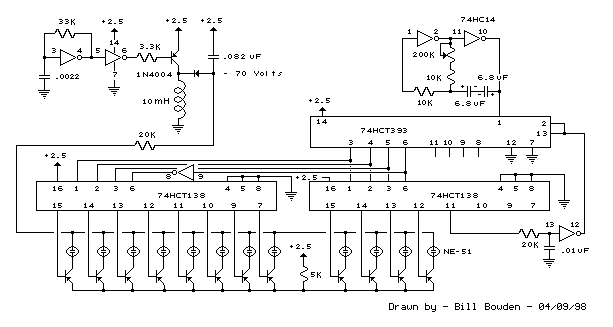
Receiver Frequency-Converter Stage
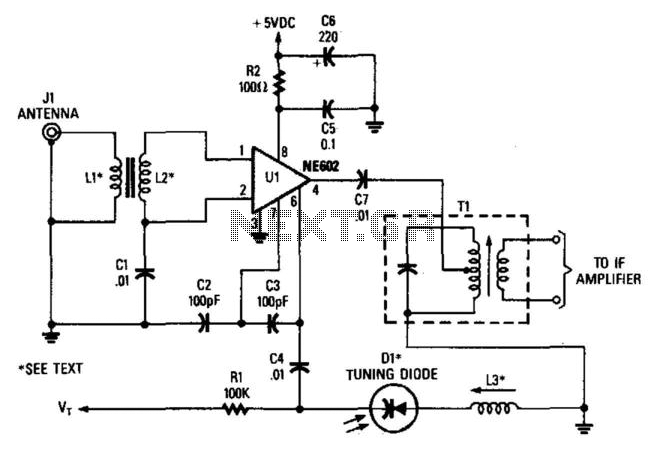
In this configuration, the NE602 serves as a frequency converter in a superheterodyne front-end setup. L1 and L2 form a broadband toroidal transformer, although a tuned transformer may also be utilized. The supply voltage ranges from +5 to +9 VDC. T1 is tuned to the intermediate frequency (IF), which is typically set at 455 kHz. The circuit can function across a frequency range from audio to 30 MHz, depending on the specifications of L1, L2, and L3. The varactor tuning diode can be substituted with an air-variable capacitor if preferred. L1 and L2 have a turns ratio of 1:12 and are implemented as a broadband toroid. L3 is designed to resonate at the local oscillator (L.O.) frequency, utilizing the capacitance of diode D1. The desired local oscillator frequency is the received frequency plus or minus the IF frequency.
The NE602 integrated circuit is a widely used component in radio frequency applications, particularly in superheterodyne receivers. This specific circuit configuration highlights its role as a frequency converter, allowing for efficient signal processing. The use of a broadband toroidal transformer (L1 and L2) is advantageous for maintaining a wide bandwidth, which is essential in applications that require the reception of signals over a broad frequency range, from audio frequencies up to 30 MHz.
The choice of supply voltage between +5 to +9 VDC provides flexibility in power requirements, accommodating various design constraints and power supply options. The tuning of T1 to the IF frequency of 455 kHz is a standard practice in superheterodyne designs, ensuring that the incoming RF signals are mixed down to a lower frequency that is easier to process.
The circuit's adaptability is further enhanced by the option to replace the varactor tuning diode with an air-variable capacitor. This substitution can be beneficial in applications where fine-tuning of the frequency is necessary or where the characteristics of the varactor diode may not meet specific performance criteria.
The turns ratio of the transformer (1:12) indicates that the primary winding has 1 turn for every 12 turns on the secondary, which is a common configuration in RF transformers to step up the voltage while maintaining impedance matching. The resonance of L3 with the capacitance of diode D1 is critical for achieving the desired local oscillator frequency, which is pivotal in determining the operational parameters of the receiver.
In summary, this circuit design effectively utilizes the NE602 and associated components to create a versatile and efficient frequency conversion stage in a superheterodyne receiver, capable of handling a wide range of frequencies while providing options for tuning and component substitution. In this case, the NE602 is used in this superhet front-end configuration. Ul serves as a frequency conve rter. L1/L2 is a broadband toroidal transformer. A tuned transformer may be used instead. The supply voltage is + 5 to +9 Vdc. Tl is tuned to the IF frequency. The typical IF frequency is 455 kHz. This circuit, depending on Ll, L2, and L3, should be usable in the frequency range from audio to 30 MHz. The varactor tuning diode can be replaced with an air-variable capacitor, if desired. Ll, L2 1:12 Turns Ratio Toroid (Broadband). L3 Resonates to L.O. Frequency with Dl capacitance. LO FREQ Desired received frequency ± IF frequency. 🔗 External reference
The NE602 integrated circuit is a widely used component in radio frequency applications, particularly in superheterodyne receivers. This specific circuit configuration highlights its role as a frequency converter, allowing for efficient signal processing. The use of a broadband toroidal transformer (L1 and L2) is advantageous for maintaining a wide bandwidth, which is essential in applications that require the reception of signals over a broad frequency range, from audio frequencies up to 30 MHz.
The choice of supply voltage between +5 to +9 VDC provides flexibility in power requirements, accommodating various design constraints and power supply options. The tuning of T1 to the IF frequency of 455 kHz is a standard practice in superheterodyne designs, ensuring that the incoming RF signals are mixed down to a lower frequency that is easier to process.
The circuit's adaptability is further enhanced by the option to replace the varactor tuning diode with an air-variable capacitor. This substitution can be beneficial in applications where fine-tuning of the frequency is necessary or where the characteristics of the varactor diode may not meet specific performance criteria.
The turns ratio of the transformer (1:12) indicates that the primary winding has 1 turn for every 12 turns on the secondary, which is a common configuration in RF transformers to step up the voltage while maintaining impedance matching. The resonance of L3 with the capacitance of diode D1 is critical for achieving the desired local oscillator frequency, which is pivotal in determining the operational parameters of the receiver.
In summary, this circuit design effectively utilizes the NE602 and associated components to create a versatile and efficient frequency conversion stage in a superheterodyne receiver, capable of handling a wide range of frequencies while providing options for tuning and component substitution. In this case, the NE602 is used in this superhet front-end configuration. Ul serves as a frequency conve rter. L1/L2 is a broadband toroidal transformer. A tuned transformer may be used instead. The supply voltage is + 5 to +9 Vdc. Tl is tuned to the IF frequency. The typical IF frequency is 455 kHz. This circuit, depending on Ll, L2, and L3, should be usable in the frequency range from audio to 30 MHz. The varactor tuning diode can be replaced with an air-variable capacitor, if desired. Ll, L2 1:12 Turns Ratio Toroid (Broadband). L3 Resonates to L.O. Frequency with Dl capacitance. LO FREQ Desired received frequency ± IF frequency. 🔗 External reference
